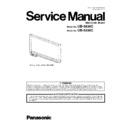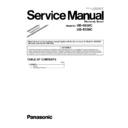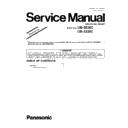Read Panasonic UB-5838C / UB-5338C Service Manual online
Order Number KM70906495CE
Category Number H19
Electronic Board
Model No.
UB-5838C
Model No.
UB-5338C
2
TABLE OF CONTENTS
PAGE
PAGE
1 General Precautions ---------------------------------------------3
1.1. Safety Precautions-----------------------------------------3
1.2. Electrical Tests ----------------------------------------------3
1.3. Standard for Repair Service -----------------------------4
1.4. For Service Technicians ----------------------------------4
1.5. About Lead Free Solder (PbF: Pb free) --------------4
1.6. About RoHS -------------------------------------------------5
1.2. Electrical Tests ----------------------------------------------3
1.3. Standard for Repair Service -----------------------------4
1.4. For Service Technicians ----------------------------------4
1.5. About Lead Free Solder (PbF: Pb free) --------------4
1.6. About RoHS -------------------------------------------------5
2 Introduction ---------------------------------------------------------6
2.1. Before using this manual ---------------------------------6
2.2. Specifications -----------------------------------------------7
2.3. External View------------------------------------------------9
2.4. Control Panel Operation-------------------------------- 10
2.5. External Dimensions ------------------------------------ 11
2.6. Main Components’ (Scanner Assy., PCB
2.2. Specifications -----------------------------------------------7
2.3. External View------------------------------------------------9
2.4. Control Panel Operation-------------------------------- 10
2.5. External Dimensions ------------------------------------ 11
2.6. Main Components’ (Scanner Assy., PCB
Assembly, and others) Locations--------------------- 13
3 Installation Instructions--------------------------------------- 15
3.1. Installation Requirements ------------------------------ 15
3.2. Minimum Space Requirements ----------------------- 15
3.3. Installing ---------------------------------------------------- 16
3.4. Operation Check and Settings before using
3.2. Minimum Space Requirements ----------------------- 15
3.3. Installing ---------------------------------------------------- 16
3.4. Operation Check and Settings before using
Panaboard ------------------------------------------------- 21
3.5. Repacking-------------------------------------------------- 23
3.6. Wall Mounting Construction --------------------------- 24
3.6. Wall Mounting Construction --------------------------- 24
4 Mechanism -------------------------------------------------------- 29
4.1. Screen Feed Mechanism ------------------------------ 29
4.2. Scanning Mechanism ----------------------------------- 30
4.2. Scanning Mechanism ----------------------------------- 30
5 Troubleshooting Guide---------------------------------------- 31
5.1. Error Code ------------------------------------------------- 31
5.2. Printing Problems ---------------------------------------- 36
5.3. Others ------------------------------------------------------- 37
5.4. Requirements after replacing and servicing ------- 39
5.2. Printing Problems ---------------------------------------- 36
5.3. Others ------------------------------------------------------- 37
5.4. Requirements after replacing and servicing ------- 39
6 Disassembly and Assembly Instructions --------------- 40
6.1. Cover -------------------------------------------------------- 40
6.2. SCANNER Board and Scanner Assy.--------------- 43
6.3. Motor Drive Unit ------------------------------------------ 45
6.4. HOME SENSOR Board--------------------------------- 46
6.5. MOTOR DRIVE Board ---------------------------------- 47
6.6. Control Box Unit ------------------------------------------ 48
6.7. Screen Roller---------------------------------------------- 54
6.8. Screen Guide R and Screen Guide L --------------- 57
6.9. Screen Film ------------------------------------------------ 59
6.2. SCANNER Board and Scanner Assy.--------------- 43
6.3. Motor Drive Unit ------------------------------------------ 45
6.4. HOME SENSOR Board--------------------------------- 46
6.5. MOTOR DRIVE Board ---------------------------------- 47
6.6. Control Box Unit ------------------------------------------ 48
6.7. Screen Roller---------------------------------------------- 54
6.8. Screen Guide R and Screen Guide L --------------- 57
6.9. Screen Film ------------------------------------------------ 59
6.10. Frame ------------------------------------------------------- 64
7 Service Mode ----------------------------------------------------- 69
7.1. How to enter the service mode ----------------------- 69
7.2. Service Mode and Initial Setting Mode ------------- 72
7.3. LCD Test Pattern ----------------------------------------- 74
7.4. Service Mode Operations ------------------------------ 75
7.2. Service Mode and Initial Setting Mode ------------- 72
7.3. LCD Test Pattern ----------------------------------------- 74
7.4. Service Mode Operations ------------------------------ 75
8 Maintenance ------------------------------------------------------ 76
8.1. Maintenance Table--------------------------------------- 76
8.2. Cleaning Screen Film ----------------------------------- 76
8.3. Caring for Eraser ----------------------------------------- 77
8.4. Replacing the Battery ----------------------------------- 78
8.2. Cleaning Screen Film ----------------------------------- 76
8.3. Caring for Eraser ----------------------------------------- 77
8.4. Replacing the Battery ----------------------------------- 78
9 Block and Connection Diagrams -------------------------- 79
9.1. Block Diagram -------------------------------------------- 79
9.2. Connection Diagram------------------------------------- 80
9.2. Connection Diagram------------------------------------- 80
10 Explanation of Connector ------------------------------------ 81
11 Schematic Diagram--------------------------------------------- 86
11.1. CONTROL Board ---------------------------------------- 87
11.2. PANEL Board --------------------------------------------- 91
11.3. SCANNER Board ---------------------------------------- 92
11.4. MOTOR DRIVE Board --------------------------------- 95
11.5. HOME SENSOR Board -------------------------------- 96
11.3. SCANNER Board ---------------------------------------- 92
11.4. MOTOR DRIVE Board --------------------------------- 95
11.5. HOME SENSOR Board -------------------------------- 96
12 Printed Circuit Board------------------------------------------ 97
12.1. CONTROL Board ---------------------------------------- 98
12.2. PANEL Board --------------------------------------------- 99
12.3. SCANNER Board ---------------------------------------- 99
12.4. MOTOR DRIVE Board -------------------------------- 100
12.5. HOME SENSOR Board ------------------------------- 100
12.2. PANEL Board --------------------------------------------- 99
12.3. SCANNER Board ---------------------------------------- 99
12.4. MOTOR DRIVE Board -------------------------------- 100
12.5. HOME SENSOR Board ------------------------------- 100
13 Exploded View and Replacement Parts List---------- 101
13.1. Framework of Projected Diagram ------------------ 102
13.2. Cabinet Unit ---------------------------------------------- 103
13.3. Motor Drive Unit / Sensor Unit ---------------------- 105
13.4. Control Box Unit----------------------------------------- 107
13.5. Screen Feed Roller Unit ------------------------------ 109
13.6. Scanner Unit --------------------------------------------- 111
13.7. Panel Unit------------------------------------------------- 113
13.8. Frame Unit------------------------------------------------ 115
13.9. Rear Cover Unit ----------------------------------------- 117
13.2. Cabinet Unit ---------------------------------------------- 103
13.3. Motor Drive Unit / Sensor Unit ---------------------- 105
13.4. Control Box Unit----------------------------------------- 107
13.5. Screen Feed Roller Unit ------------------------------ 109
13.6. Scanner Unit --------------------------------------------- 111
13.7. Panel Unit------------------------------------------------- 113
13.8. Frame Unit------------------------------------------------ 115
13.9. Rear Cover Unit ----------------------------------------- 117
13.10. Packing---------------------------------------------------- 119
13.11. CONTROL Board --------------------------------------- 121
13.12. SCANNER Board --------------------------------------- 131
13.13. PANEL Board -------------------------------------------- 134
13.14. MOTOR DRIVE Board -------------------------------- 136
13.15. SENSOR CIRCUIT Board ---------------------------- 136
13.13. PANEL Board -------------------------------------------- 134
13.14. MOTOR DRIVE Board -------------------------------- 136
13.15. SENSOR CIRCUIT Board ---------------------------- 136
3
1 General Precautions
1.1.
Safety Precautions
1.2.
Electrical Tests
1. Unplug the power cord and check for continuity between the earth ground connection on the plug and the metal cabinet.
There should be zero ohm resistance found.
2. With the unit unplugged, short the AC Live-Neutral of the plug with a jumper wire.
3. Turn ON the power switch.
4. Measure the resistance value with an ohmmeter between the jumpered AC plug and each exposed metal cabinet part, such
3. Turn ON the power switch.
4. Measure the resistance value with an ohmmeter between the jumpered AC plug and each exposed metal cabinet part, such
as screwheads, etc.
Note
Some exposed parts may be isolated from the chassis by design. They read infinity.
Note
Some exposed parts may be isolated from the chassis by design. They read infinity.
5. If the measurement is less than 1 M
Ω
, a possibility for electric shock may exit.
Note
This hazardous condition must be corrected before the unit is returned to the end user.
This hazardous condition must be corrected before the unit is returned to the end user.
4
1.3.
Standard for Repair Service
Repair service shall be provided in accordance with repair technology information such as service manual
so as to prevent fires, injury or electric shock, which can be caused by improper repair work.
so as to prevent fires, injury or electric shock, which can be caused by improper repair work.
1. When performing repairs, neither the products nor its parts or components shall be modified.
2. If cable assembly is supplied as the smallest unit when servicing, make sure to replace
2. If cable assembly is supplied as the smallest unit when servicing, make sure to replace
the cable assembly.
1.4.
For Service Technicians
ICs and LSIs are vulnerable to static electricity.
When repairing, the following precautions will help to prevent recurring malfunctions.
When repairing, the following precautions will help to prevent recurring malfunctions.
1. Cover the plastic parts with aluminum foil.
2. Ground the soldering irons.
3. Use a conductive mat on the worktable.
4. Do not grasp IC or LSI pins with bare fingers.
2. Ground the soldering irons.
3. Use a conductive mat on the worktable.
4. Do not grasp IC or LSI pins with bare fingers.
1.5.
About Lead Free Solder (PbF: Pb free)
Note
• In the information below, Pb, the symbol for lead in the periodic table of elements, will refer to standard solder or solder
that contains lead.
• We will use PbF when discussing the lead free solder used in our manufacturing process which is made from Tin (Sn),
Silver (Ag), and Copper (Cu).
• This model, and others like it, manufactured using lead free solder will have PbF stamped on the PCB. For service and
repair work we suggest using the same type of solder.
Distinction of PbF PCB
• PCBs (manufactured) using lead free solder will have a PbF stamp on the PCB.
Caution
• PbF solder has a melting point that is 50
°
- 70
°
F, (30
°
- 40
°
C) higher than Pb solder.
Please use a soldering iron with temperature control and adjust it to 700
°
± 20
°
F (370
°
± 10
°
C).
• Exercise care while using higher temperature soldering irons.: Do not heat the PCB for too long time in order to
prevent solder splash or damage to the PCB.
• PbF solder will tend to splash if it is heated much higher than its melting point, approximately 1100
°
F (600
°
C).
• When applying PbF solder to double layered boards, please check the component side for excess solder which may
flow onto the opposite side (See figure below)
1.5.1.
Suggested Pb free solder
We recommend you to use the following solder when re-soldering components for repair. Before using other Pb free solder than the
following solder, make sure to confirm that the solder maker (you use) has the license agreement for Pb free solder.
following solder, make sure to confirm that the solder maker (you use) has the license agreement for Pb free solder.
Supplier: Senju Metal Industry Co., Ltd. (http://www.senju-m.co.jp)
Part Description in Senju: EcoSolder RMA02 P3 M705 Series
Part Description in Senju: EcoSolder RMA02 P3 M705 Series



